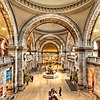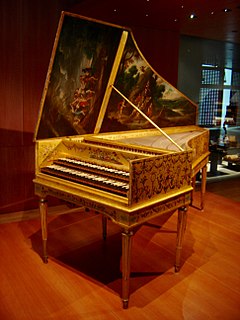
A harpsichord is a musical instrument played by means of a keyboard. Like a pipe organ, a harpsichord may have more than one keyboard manual and harpsichords may have stop buttons which add or remove additional octaves. Some harpsichords may have a lute stop, which simulates the sound of a plucked lute. This activates a row of levers that turn a trigger mechanism that plucks one or more strings with a small plectrum made from quill or plastic. The strings are under tension on a soundboard, which is mounted in a wooden case; the soundboard amplifies the vibrations from the strings so that the listeners can hear it.

The virginals is a keyboard instrument of the harpsichord family. It was popular in Europe during the late Renaissance and early baroque periods.

Abraham Bloemaert was a Dutch painter and printmaker in etching and engraving. He was one of the "Haarlem Mannerists" from about 1585, but in the new century altered his style to fit new Baroque trends. He mostly painted history subjects and some landscapes. He was an important teacher, who trained most of the Utrecht Caravaggisti, at least for a period.

The Fitzwilliam Virginal Book is a primary source of keyboard music from the late Elizabethan and early Jacobean periods in England, i.e., the late Renaissance and very early Baroque. It takes its name from Viscount Fitzwilliam who bequeathed this manuscript collection to Cambridge University in 1816. It is now deposited in the Fitzwilliam Museum at Cambridge. Although the word virginals or virginal is used today to refer to a specific instrument similar to a small, portable harpsichord, at the time of the book the word was used to denote virtually any keyboard instrument including the organ.
The Ruckers family were harpsichord and virginal makers from the Southern Netherlands based in Antwerp in the 16th and 17th century. Their influence stretched well into the 18th century, and to the harpsichord revival of the 20th.

Pieter Lastman (1583–1633) was a Dutch painter. Lastman is considered important because of his work as a painter of history pieces and because his pupils included Rembrandt and Jan Lievens. In his paintings Lastman paid careful attention to the faces, hands and feet.

Maerten de Vos, Maerten de Vos the Elder or Marten de Vos was a Flemish painter mainly of history paintings and portraits. He became, together with the brothers Ambrosius Francken I and Frans Francken I, one of the leading history painters in the Spanish Netherlands after Frans Floris’ career slumped in the second half of the sixteenth century as a result of the Iconoclastic fury of the Beeldenstorm.
The Mulliner Book is a historically important musical commonplace book compiled, probably between about 1545 and 1570, by Thomas Mulliner, about whom practically nothing is known, except that he figures in 1563 as modulator organorum (organist) of Corpus Christi College, Oxford. He is believed to have previously resided in London, where John Heywood inscribed the title page of the manuscript Sum liber thomas mullineri / iohanne heywoode teste. A later annotation on the same page states that: T. Mulliner was Master of St Pauls school, but this has so far proved unsupportable. The provenance of the MS is unknown before it appears in the library of John Stafford Smith in 1776. After passing through the hands of Edward Francis Rimbault the MS was given to the British Museum in 1877 by William Hayman Cummings.
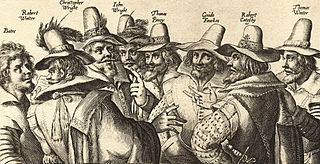
Crispijn van de Passe the Elder, or de Passe was a Dutch publisher and engraver and founder of a dynasty of engravers comparable to the Wierix family and the Sadelers, though mostly at a more mundane commercial level. Most of their engravings were portraits, book title-pages, and the like, with relatively few grander narrative subjects. As with the other dynasties, their style is very similar, and hard to tell apart in the absence of a signature or date, or evidence of location. Many of the family could produce their own designs, and have left drawings.

Lady Seated at a Virginal, also known as Young Woman Seated at a Virginal, is a genre painting created by Dutch artist Johannes Vermeer in about 1670–72 and now in the National Gallery, London.
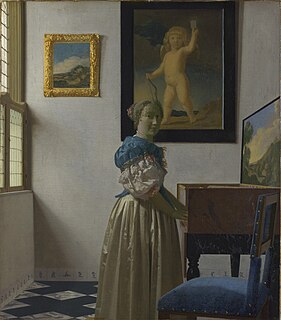
Lady Standing at a Virginal is a genre painting created by the Dutch artist Johannes Vermeer in about 1670–1672, now in the National Gallery, London.

Schelte a Bolswert (1586–1659) was a leading Dutch engraver, noted for his works after Rubens and Van Dyck.
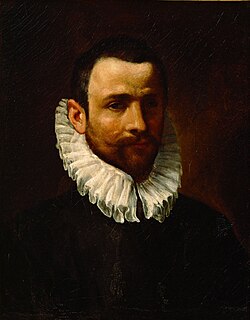
Lodewijk Toeput, called il Pozzoserrato was a Flemish landscape painter and draftsman active in Italy. He is mainly known for his canvases and frescoes of landscapes and formal gardens with banquets and music-making groups. His landscapes had an important influence on the next generation of Flemish landscape artists such as Joos de Momper, Tobias Verhaecht and Gillis and Frederik van Valckenborch.

Petrus, or Pieter de Jode I or Pieter de Jode the Elder, was a Flemish printmaker, draughtsman, publisher and painter active principally active in Antwerp. He was active as a reproductive artist who created many prints after the works of leading painters and was in addition a prolific designer of prints for Antwerp publishers.
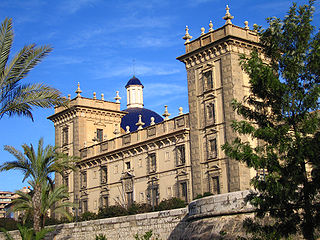
The Museu de Belles Arts de València is an art gallery in Valencia, Spain, founded in 1913. It houses some 2,000 works, most dating from the 14th–17th centuries, including a Self portrait of Diego Velázquez, a St. John the Baptist by El Greco, Goya's Playing Children, Gonzalo Pérez's Altarpiece of Sts. Ursula, Martin and Antony and a Madonna with Writing Child and Bishop by the Italian Renaissance master Pinturicchio. It houses a large series of engravings by Giovan Battista Piranesi.
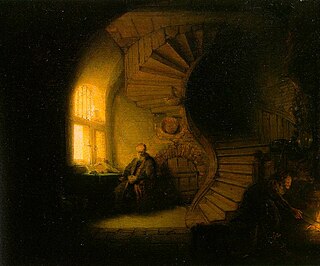
Philosopher in Meditation is the traditional title of an oil painting in the Musée du Louvre, Paris, that has long been attributed to the 17th-century Dutch artist Rembrandt.

Ambrosius Francken I (1544–1618) was a Flemish painter known for his religious works and historical allegories painted in a late Mannerist style. He was a prominent member of the Francken family of artists, which played a very important role in the Flemish art scene from the late 16th to middle 17th century.

Belshazzar's Feast is an oil painting by British painter John Martin (1789–1854). It was first exhibited at the British Institution in February 1821 and won a prize of £200 for the best picture. It was so popular that it needed to be protected from the crowds by a railing, and established Martin's fame. In the words of Martin's biographer William Feaver, he "turned literary references to visual reality". Martin published mezzotint engravings in 1826 and 1832. The original painting is now held in a private collection; two smaller contemporaneous "sketches" are held by the Yale Center for British Art in New Haven, Connecticut and the Wadsworth Atheneum in Hartford, Connecticut.
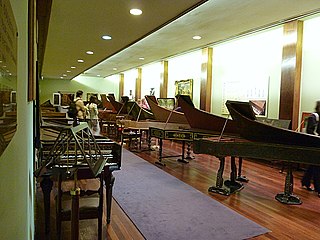
The Russell Collection is a substantial collection of early keyboard instruments assembled by the British harpsichordist and organologist Raymond Russell. It forms part of the Musical Instrument Museums collection of the University of Edinburgh, and is housed in St Cecilia's Hall. Its full name is the Raymond Russell Collection of Early Keyboard Instruments.

Mary Elizabeth Adams Brown was an American writer, collector, and curator of musical instruments.






















